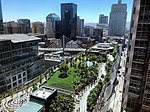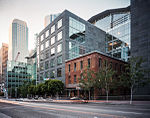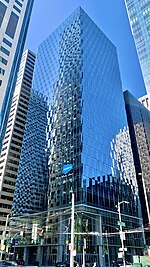San Francisco Transbay Terminal

The San Francisco Transbay Terminal was a transportation complex in San Francisco, California, United States, roughly in the center of the rectangle bounded north–south by Mission Street and Howard Street, and east–west by Beale Street and 2nd Street in the South of Market area of the city. It opened on January 14, 1939 as a train station and was converted into a bus depot in 1959. The terminal mainly served San Francisco's downtown and Financial District, as transportation from surrounding communities of the Bay Area terminated there such as: Golden Gate Transit buses from Marin County, AC Transit buses from the East Bay, and SamTrans buses from San Mateo County. Long-distance buses from beyond the Bay Area such as Greyhound and Amtrak also served the terminal. Several bus lines of the San Francisco Municipal Railway connected with the terminal. It closed on August 7, 2010, to make way for the construction of the replacement facility, the Transbay Transit Center, and associated towers. All long-distance and transbay bus operations were transferred to a Temporary Transbay Terminal at the nearby block bounded by Main, Folsom, Beale, and Howard Streets. The new Transbay Transit Center broke ground on August 11, 2010. US Secretary of Transportation Ray LaHood, US Speaker of the House Nancy Pelosi, and the Mayor of San Francisco Gavin Newsom attended the ceremony. The new transit center opened to the public on August 12, 2018.
Excerpt from the Wikipedia article San Francisco Transbay Terminal (License: CC BY-SA 3.0, Authors, Images).San Francisco Transbay Terminal
Mission Street, San Francisco
Geographical coordinates (GPS) Address Nearby Places Show on map
Geographical coordinates (GPS)
| Latitude | Longitude |
|---|---|
| N 37.789444444444 ° | E -122.39638888889 ° |
Address
Salesforce Transit Center (Transbay Transit Center)
Mission Street 425
94105 San Francisco
California, United States
Open on Google Maps










